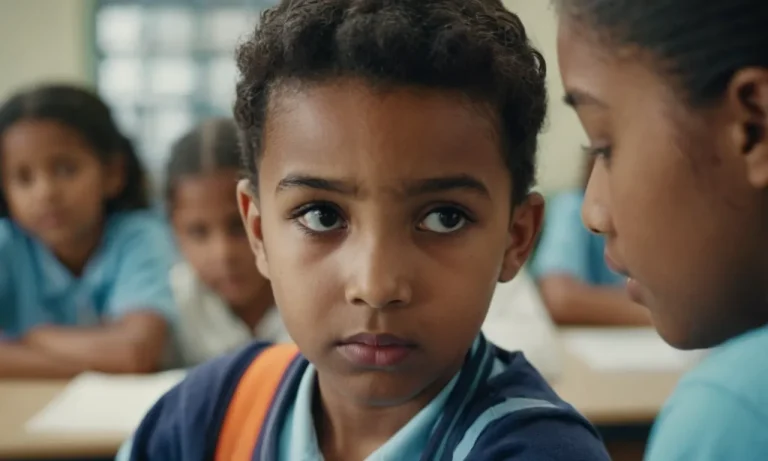Unraveling the mysteries of child development has captivated researchers, educators, and parents alike for centuries. From the earliest stages of infancy to the tumultuous years of adolescence, understanding how children grow, learn, and evolve is a fascinating and complex endeavor.
If you’re short on time, here’s a quick answer to your question: The best known theories of child development include Piaget’s Theory of Cognitive Development, Erikson’s Psychosocial Theory, Bandura’s Social Learning Theory, and Bronfenbrenner’s Ecological Systems Theory.
In this comprehensive article, we will delve into the intricacies of these influential theories, exploring their key principles, contributions, and practical applications. We will also examine the historical context in which these theories emerged and their lasting impact on our understanding of child development.
Piaget’s Theory of Cognitive Development
Overview of Piaget’s Theory
Piaget’s theory of cognitive development is a comprehensive theory that explores how children acquire knowledge and construct their understanding of the world. Developed by the Swiss psychologist Jean Piaget (1896-1980), this theory has had a profound impact on our understanding of child development and has influenced educational practices worldwide.
According to Piaget, children are not passive recipients of knowledge but active learners who construct their understanding through interactions with their environment. He proposed that cognitive development occurs in a series of stages, each characterized by distinct ways of thinking and understanding the world.
Piaget believed that children progress through these stages in a fixed order, and their ability to understand complex concepts is limited by their current stage of cognitive development. Learn more about Piaget’s theory at VeryWell Mind.
The Four Stages of Cognitive Development
Piaget identified four distinct stages of cognitive development:
- Sensorimotor Stage (Birth to 2 years): During this stage, infants learn through their senses and physical interactions with the environment. They develop object permanence and begin to understand cause and effect.
- Preoperational Stage (2 to 7 years): Children in this stage develop language and symbolic thinking but struggle with abstract concepts and logical reasoning. Their thinking is often egocentric.
- Concrete Operational Stage (7 to 11 years): Children can now perform logical operations and understand concrete concepts, such as conservation of volume and number. However, they still struggle with abstract ideas.
- Formal Operational Stage (11 years and beyond): During this stage, individuals develop the ability to think abstractly, reason hypothetically, and understand complex concepts.
It’s important to note that while Piaget’s theory provides a general framework, individual children may progress through these stages at different rates, and the age ranges are approximations. Additionally, recent research has challenged some aspects of Piaget’s theory, suggesting that cognitive development may be more continuous and gradual than Piaget proposed.
Implications for Education and Parenting
Piaget’s theory has had significant implications for education and parenting practices. By understanding the cognitive abilities and limitations of children at different stages, educators and parents can tailor their teaching methods and interactions to better support a child’s learning and development.
For example, in the early stages, hands-on activities and concrete experiences are crucial for fostering understanding. As children progress, educators can gradually introduce more abstract concepts and encourage logical reasoning and problem-solving skills.
Understood.org provides practical tips for applying Piaget’s theory in the classroom.
Additionally, Piaget’s emphasis on active learning and allowing children to explore and construct their own knowledge has influenced educational approaches such as inquiry-based learning and child-centered education.
Parents and caregivers can also apply Piaget’s principles by engaging children in age-appropriate activities, encouraging curiosity, and fostering a love for learning.
While Piaget’s theory has faced criticism and revisions over time, it remains a foundational and influential framework for understanding cognitive development in children. Its insights continue to shape educational practices and parenting approaches, ultimately aiming to support children’s growth and learning in a developmentally appropriate manner.
Erikson’s Psychosocial Theory
Developed by the renowned psychologist Erik Erikson, the psychosocial theory of development is a widely recognized and influential model that explores the impact of social experiences on an individual’s psychological growth and identity formation.
This theory offers a comprehensive framework for understanding human development across the lifespan, emphasizing the interplay between psychological needs and societal influences.
The Eight Stages of Psychosocial Development
Erikson’s theory proposes eight distinct stages of psychosocial development, each characterized by a unique psychosocial crisis or conflict that must be resolved for healthy development to occur. These stages are:
- Trust vs. Mistrust (Infancy)
- Autonomy vs. Shame and Doubt (Early Childhood)
- Initiative vs. Guilt (Preschool Age)
- Industry vs. Inferiority (School Age)
- Identity vs. Role Confusion (Adolescence)
- Intimacy vs. Isolation (Young Adulthood)
- Generativity vs. Stagnation (Middle Adulthood)
- Ego Integrity vs. Despair (Late Adulthood)
According to Erikson, successfully navigating these psychosocial crises is crucial for developing a strong sense of self and achieving psychological well-being. For instance, the identity crisis during adolescence is a pivotal stage where individuals explore their beliefs, values, and roles in society, ultimately shaping their sense of identity.
Identity Formation and the Adolescent Crisis
The fifth stage of Erikson’s theory, “Identity vs. Role Confusion,” is particularly significant as it marks the transition from childhood to adulthood. During this stage, adolescents grapple with questions of “Who am I?” and “What is my purpose in life?”
They explore various roles, beliefs, and identities, seeking a coherent sense of self. Failure to resolve this crisis can lead to role confusion and a fragmented sense of identity.
Erikson emphasized the importance of societal influences, such as peer groups, cultural norms, and historical events, in shaping an individual’s identity formation. For example, a study by the American Psychological Association found that adolescents who experienced supportive relationships and positive role models were more likely to develop a strong, positive sense of identity.
On the other hand, those who faced discrimination or lacked guidance were more prone to identity confusion and psychological distress.
Fostering Healthy Psychosocial Development
To promote healthy psychosocial development, it is crucial to provide supportive environments and opportunities for individuals to navigate the various stages successfully. This can involve:
- Encouraging open communication and fostering trust in early childhood
- Promoting autonomy and allowing children to make age-appropriate choices
- Providing opportunities for initiative and creativity in preschool years
- Recognizing and celebrating achievements to build a sense of competence in school-aged children
- Offering guidance and role models during adolescence to support identity formation
- Nurturing intimate relationships and fostering a sense of belonging in young adulthood
- Encouraging generativity and contributing to society in middle adulthood
- Promoting self-acceptance and finding meaning in later life stages
By understanding the psychosocial stages and their corresponding challenges, parents, educators, and mental health professionals can better support individuals in navigating the complexities of human development.
Erikson’s theory serves as a powerful framework for fostering psychological well-being and nurturing a strong, integrated sense of self throughout the lifespan.
Bandura’s Social Learning Theory
Developed by renowned psychologist Albert Bandura, the Social Learning Theory is a highly influential and widely accepted theory in the field of child development. It emphasizes the crucial role of observational learning and modeling in shaping a child’s behavior, cognition, and emotional responses.
The Concept of Observational Learning
Bandura’s theory posits that children learn a significant portion of their behaviors by observing others, particularly role models such as parents, teachers, or peers. Through this process of observational learning, children acquire new knowledge, skills, and patterns of behavior without directly experiencing the consequences themselves.
According to VeryWellMind, observational learning involves four key components: attention, retention, reproduction, and motivation.
- Attention: Children must pay attention to the modeled behavior to learn from it.
- Retention: They must remember the observed behavior for future imitation.
- Reproduction: Children must have the physical and cognitive capabilities to reproduce the observed behavior.
- Motivation: They must have the motivation or incentive to imitate the behavior.
The Role of Modeling and Reinforcement
Bandura’s theory highlights the significance of modeling, where children observe and imitate the behaviors of others, particularly those they perceive as influential or admirable. 😎 Modeling can be direct, where the child observes the behavior in person, or vicarious, where the behavior is observed through media or other indirect means.
The theory also emphasizes the role of reinforcement, where behaviors that are rewarded or positively reinforced are more likely to be repeated and learned.
According to SimplyPsychology, studies have shown that children are more likely to imitate behaviors that result in positive consequences or rewards. For instance, if a child observes a sibling receiving praise for sharing toys, they may be more inclined to imitate that behavior in the future.
Applications in Behavior Modification
Bandura’s Social Learning Theory has had a profound impact on various fields, including education, parenting, and behavior modification. It has been widely applied in classroom settings, where teachers use modeling techniques to promote positive behaviors and discourage negative ones.
In therapy and counseling, the theory has been utilized to develop effective behavior modification programs for children and adolescents.
For example, the American Psychological Association highlights the use of modeling and reinforcement techniques in treating phobias, anxiety disorders, and other behavioral issues in children. By observing and imitating the desired behaviors modeled by therapists or peers, children can gradually overcome their fears or modify their problematic behaviors.
Bronfenbrenner’s Ecological Systems Theory
Developed by renowned psychologist Urie Bronfenbrenner, the Ecological Systems Theory is a groundbreaking framework that explores the intricate interplay between a child’s development and their surrounding environment.
This theory revolutionized our understanding of child development by acknowledging the profound influence of various environmental systems on a child’s growth and well-being.
The Five Environmental Systems
Bronfenbrenner proposed five interconnected systems that shape a child’s development:
- Microsystem: The immediate environment, including family, school, and peer groups, where the child directly interacts and experiences the most significant influences.
- Mesosystem: The interactions and connections between the various microsystems, such as the relationship between home and school.
- Exosystem: The broader social settings that indirectly impact the child, like a parent’s workplace or community resources.
- Macrosystem: The overarching cultural values, beliefs, and ideologies of the society in which the child is raised.
- Chronosystem: The dimension of time, encompassing life events and transitions that influence the child’s development over the course of their life.
The Interplay of Nature and Nurture
Bronfenbrenner’s theory emphasizes the dynamic interplay between a child’s innate biological characteristics (nature) and the environmental influences (nurture). It recognizes that a child’s development is not solely determined by either nature or nurture but rather by the complex interactions between the two.
According to the CDC, this perspective highlights the importance of considering multiple levels of influence on behavior and development.
For example, a child’s temperament (nature) may shape how they respond to their family environment (nurture), which in turn can influence their social skills and emotional regulation. Conversely, a supportive and nurturing environment can help mitigate the effects of genetic predispositions or developmental challenges.
Implications for Child Development Policies
Bronfenbrenner’s Ecological Systems Theory has profound implications for child development policies and practices. By recognizing the interconnectedness of various environmental systems, it emphasizes the need for a holistic approach to supporting children’s growth.
Policies and interventions should target not only the child’s immediate environment but also the broader social, cultural, and economic factors that shape their development.
For instance, UNICEF’s Early Childhood Development program adopts an ecological approach, focusing on improving access to quality healthcare, education, and nurturing environments for young children worldwide.
It acknowledges that a child’s well-being is influenced by factors ranging from family support to community resources and national policies.
By embracing Bronfenbrenner’s theory, policymakers and practitioners can develop comprehensive strategies that address the multifaceted nature of child development, ultimately fostering healthier and more resilient communities for children to thrive. 😊
Conclusion
The theories of Piaget, Erikson, Bandura, and Bronfenbrenner have profoundly shaped our understanding of child development, offering invaluable insights into the cognitive, psychosocial, behavioral, and environmental factors that influence a child’s growth and maturation.
While each theory presents a unique perspective, they collectively underscore the complexity and multidimensional nature of child development. By integrating these theories into educational practices, parenting strategies, and policy decisions, we can create nurturing environments that foster the holistic development of children, empowering them to reach their full potential.






